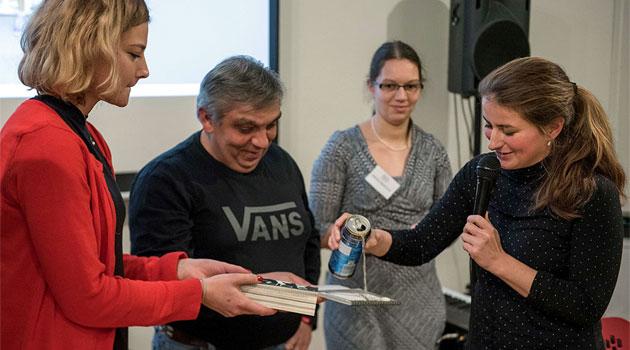Review: Czech artist's "guide" to slumming in Brno's Romani neighborhood is a tasteless mockery

“A Guide to the Brno Bronx – BRNOX – a Kateřina Šedá action” is the entire title of a publication that has recently sold out here in the Czech Republic. Its second subtitle (“a Kateřina Šedá action”) tells you all you really need to know.
When the authors of this guidebook were collecting material for it, they asked me for some minor aid in translating several vulgarisms from the Hungarian. Understandably, I assisted them – the idea seemed more than engaging, their reputations promised to deliver something unique, and I am glad to make Hungarian understandable to anybody, anywhere.
For that reason, I am now featured in the colophon of the publication as one of the translators they collaborated with – and I am not happy about it. When I first took a cursory interest in the planned book, my impression was that the authorial team – Kateřina Šedá, Aleš Palán and Lucie Faulerová – were planning to produce an original concept that would demystify this particular “black locality” by making it more accessaible, “humanizing” it, ridding it of its reputation as an exotic wilderness.
The final, sophisticated publcation has been attentively, carefully and frequently attractively produced (especially in terms of graphic design). It is also the absolute opposite of the concept I thought it would embody.
Contains trace amounts of dignity
The authors have leaned on a rather original scheme of “routes” through the area, each with its own color, the aim of which is to “lead” the reader through a particular topic, as if they were holding their hand as they walked down Cejl Street in Brno. Instead of taking a trip to visit people who are friends, loved ones and relatives, however, this is a pilgrimage through Bizarroland, full of loony laughter, “crazy” attractions and the widest possible range of “performance art” pieces staged with appropriately spicy outcomes.
The resulting impression, as a consequence, is no different from going to an Indian reservation in the USA, taking a selfie first with the Sherriff, then posing with the Chief, and finally visiting the souvenir stand to buy a headdress, a mock-up of some “fire water” and a baseball cap with a really “sick” inscription on it in the local language. That impression, unfortunately, is not changed by any of the more seriously-conceived routes, such as the violet-colored route dedicated to the Holocaust.
That route is comprised of biographies of the Jewish people who were transported away from the Cejl area during the 1940s, accompanied by photodocumentation of their former homes and of thematically related buildings. Here I would be glad to highlight at least one idea that is impressive and “playful” without also somehow making this topic too picturesque, and that is the printing of all the photodocumentation in this section as negatives – but since this violet-colored route is surrounded by one “wild” area after another, it remains somewhat isolated and lost.
The Holy Trinity of argumentation
Argument Number One in defense of this guide is that it is “art” – but the simplicity of that argument, of course, inspires not indignation, but laughter. If the artist wants, along with the recipient of her art, to freely enjoy the playfulness of creation unencumbered by her readers’ attitudes, political interference or prejudices, then she could hardly have touched upon a topic less suitable for that than an excluded locality, a theme that is a priori, inherently political.
A creative person who does not intend to voluntarily close her eyes to the full spectrum of possibilities must be aware that when context is lacking, it will always be completely, immediately, and readily filled in along the readers’ habitual lines of thought, and that there are lots of eager ideological leaders who are just waiting to put such finishing touches on any work, as well as “ordinary people” trembling with eagerness to confirm their own personally-experienced dogmas when, nota bene, the confirmation comes from the hands of the “elites”. In this and other respects, the entire guidebook “action” is taking place at exactly the same level as that of Tereza Boučková’s novel Rok kohouta (Year of the Rooster) and the commotion it once caused.
Argument Number Two in defense of BRNOX is that, like Boučková, Šedá has just created an artistic rendering of “reality”. At this point, one must stop and ask: Is her creative mind actually so limited in its vision that she is unable to recognize that the “reality” presented on the basis of these impressions and stand-alone stories, pre-selected according to how attractive they will be for her readers, can hardly result in anything more complex than merely a random sequence of tempting anecdotes, a Panopticon of curiosities?
Which brings us to Argument Number Three: “Don’t you have a sense of humor?” Those who make that argument say many Romani people living in the locality are enthusiastic about the book and able to laugh at themselves.
My question for those making this argument is: Would you laugh at yourself if somebody photographed you in an unflattering position, in one of your more single-minded moments, with a drunken grimace on your face and in a state of undress? Sure you would – you’re not too touchy to see how comic you look.
To top it all off, you’d even get a little bit of a hidden pleasure from the interaction – somebody is involved with you, laughing with you, talking with you. What, however, would happen if somebody took that revealing image, printed it in multiple copies, and sent it out into the world as a representative image of your?
Will you still be laughing then?
Far from Hrabal
Finally we come to Argument Number Four. I’ve not heard anybody actually make this argument – I came up with it on my own when I was attempting to collect some “pluses” about this publication, the potential and “spirit” of which I had hopes for when it was being prepared.
That argument asks: Isn’t this guidebook ultimately based on the poetics, the specifics of this place – as we already know them, for example, from the short stories of Bohumil Hrabal or Jan Zábrana? Good, let’s say we assume the target audience already has the aesthetic capital necessary to grasp that kind of involuntary beauty.
When, however, we look more closely at the ways in which this publication teases out such involuntary moments, this is what we find: The performance art idea to create fictitious graphic representations of well-known buildings from elsewhere in the country (such as the Dancing House in Prague) and then present them to the residents of Cejl as a “proposal for a Romani Embassy”. The resulting texts then collect the responses of these (“ignorant”) people who seem to believe in the feasibility of such a project and react to it (“funnily”).
“How cute,” one might say – assuming that one could ignore this Pragocentrism, this confident conviction about one’s own cultural horizons being a representative sample of society as a whole, and this elitist distancing by entities who do not hesitate and are willing to subject their fellow human beings to this sophisticated trolling. We can only somewhat swallow this when it involves adults, but it becomes inedible the moment the gloating viewfinder targets Romani children – to which the pink-colored route is entirely devoted.
The children of Cejl Street come out of the BRNOX guidebook looking like neglected, not too bright, opportunistic, but understandably also “touching” beings condemned in advance to a life of failure. Their “inadaptability”, “unhealthy diet”, inability to understand primitive instructions, and the “bad role models in their families” are profusely documented here, without any context, through remarks made by teachers and illustrative reprints of failures in their schoolwork, quotes of their crude vocabulary, and even through a letter authored by the director of the Museum of Romani Culture in Brno, who lobbies City Hall to help one “decent” (and understandably, isolated) Romani family escape the ghetto with its “high accumulation of offending Romani families” by telling the story of a gifted Romani pianist, said to be a “little Mozart” from a family of wunderkinds (the boy’s piano in his parents’ home is out of tune, but his piano teacher’s, elsewhere in town, is ‘tuned, understandably’) – which just perfectly underlines the entire impression that the neighborhood is a menagerie from which one must flee, as soon as possible, in the interest of preserving basic civilizational customs.
ANTI-BRNOX?
There is one more perspective that is supposed to justify the tone of BRNOX. According to this perspective, the guide is “not about Romani people”, and, in the words of one of the book’s authors, “no such thing as a locality even exists”.
It is actually the case that the guidebook’s “Holocaust route” is dedicated to Jewish people, and that some partial anecdotes and roughly 10 % of this “collection” of remarks are about other ethnicities: Chinese people, Ukrainian people, Vietnamese people, even immigrants from the continent of Africa. However, given the extent of the vocabulary that is represented in the guidebook, the characteristics of people’s names and surnames, and the multiple complaints quoted that refer explicitly to ethnic Roma, we can only speculate as to whether the authors were naive, or whether they were unwilling to reflect on the fact that their (sometimes non-ironic) brilliant ideas have been, in this Guide to the “Bronx”, largely absorbed by their need to present their own brilliance and by their hunger for a literary sensation.
Localities do exist, even if you don’t live in one yourself and “don’t know anything about it”. Those who live around and outside of your locality always know where it is, and when an outsider wants to, he can always use it against you.
